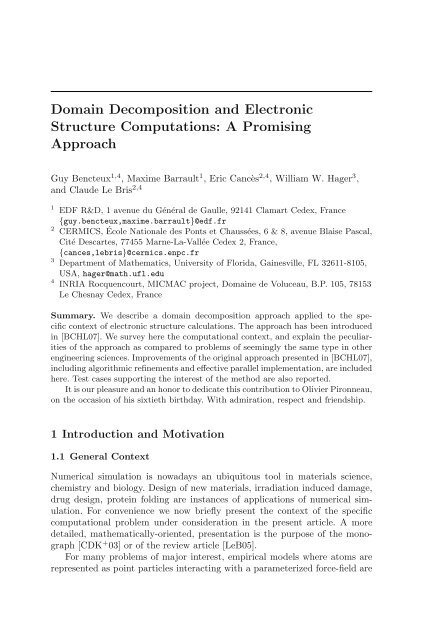Partial Differential Equations - Modelling and ... - ResearchGate
Partial Differential Equations - Modelling and ... - ResearchGate
Partial Differential Equations - Modelling and ... - ResearchGate
Create successful ePaper yourself
Turn your PDF publications into a flip-book with our unique Google optimized e-Paper software.
Domain Decomposition <strong>and</strong> Electronic<br />
Structure Computations: A Promising<br />
Approach<br />
Guy Bencteux 1,4 , Maxime Barrault 1 , Eric Cancès 2,4 , William W. Hager 3 ,<br />
<strong>and</strong> Claude Le Bris 2,4<br />
1 EDF R&D, 1 avenue du Général de Gaulle, 92141 Clamart Cedex, France<br />
{guy.bencteux,maxime.barrault}@edf.fr<br />
2 CERMICS, École Nationale des Ponts et Chaussées, 6 & 8, avenue Blaise Pascal,<br />
Cité Descartes, 77455 Marne-La-Vallée Cedex 2, France,<br />
{cances,lebris}@cermics.enpc.fr<br />
3 Department of Mathematics, University of Florida, Gainesville, FL 32611-8105,<br />
USA, hager@math.ufl.edu<br />
4 INRIA Rocquencourt, MICMAC project, Domaine de Voluceau, B.P. 105, 78153<br />
Le Chesnay Cedex, France<br />
Summary. We describe a domain decomposition approach applied to the specific<br />
context of electronic structure calculations. The approach has been introduced<br />
in [BCHL07]. We survey here the computational context, <strong>and</strong> explain the peculiarities<br />
of the approach as compared to problems of seemingly the same type in other<br />
engineering sciences. Improvements of the original approach presented in [BCHL07],<br />
including algorithmic refinements <strong>and</strong> effective parallel implementation, are included<br />
here. Test cases supporting the interest of the method are also reported.<br />
It is our pleasure <strong>and</strong> an honor to dedicate this contribution to Olivier Pironneau,<br />
on the occasion of his sixtieth birthday. With admiration, respect <strong>and</strong> friendship.<br />
1 Introduction <strong>and</strong> Motivation<br />
1.1 General Context<br />
Numerical simulation is nowadays an ubiquitous tool in materials science,<br />
chemistry <strong>and</strong> biology. Design of new materials, irradiation induced damage,<br />
drug design, protein folding are instances of applications of numerical simulation.<br />
For convenience we now briefly present the context of the specific<br />
computational problem under consideration in the present article. A more<br />
detailed, mathematically-oriented, presentation is the purpose of the monograph<br />
[CDK + 03] or of the review article [LeB05].<br />
For many problems of major interest, empirical models where atoms are<br />
represented as point particles interacting with a parameterized force-field are
















